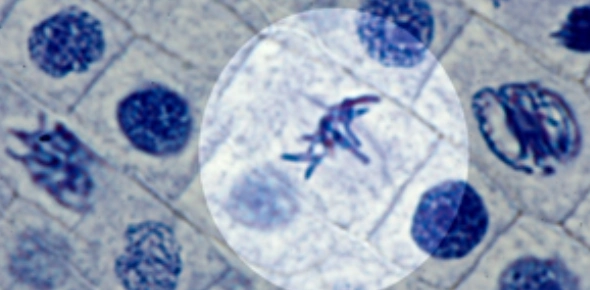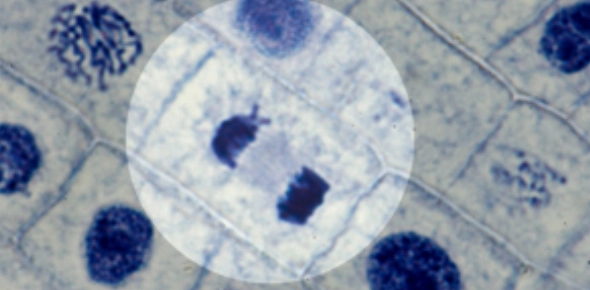Cell Division 7th Grade Quiz Questions
.webp)
A quiz basically using vocabulary about mitosis and meiosis intended for middle school science. (south carolina standards - 7th grade)
- 1.
What is an organism reproduced by one or two parents?
- A.
Daughter cell
- B.
Offspring
- C.
Asexual reproduction
Correct Answer
B. OffspringExplanation
Offspring refers to the new individuals that are produced through the reproduction of one or two parents. This term is commonly used to describe the result of sexual reproduction, where genetic material from both parents combines to create a unique individual. Offspring can inherit traits from both parents, resulting in genetic diversity.Rate this question:
-
- 2.
What is meiosis?
- A.
A special type of cell division producing haploid cells
- B.
A special type of cell division producing diploid cells
- C.
A special type of cell division producing parent cells
Correct Answer
A. A special type of cell division producing haploid cellsExplanation
Meiosis is a special type of cell division that produces haploid cells. Haploid cells have half the number of chromosomes as the parent cells. This process is essential for sexual reproduction as it ensures that the resulting offspring will have the correct number of chromosomes. Meiosis involves two rounds of cell division, resulting in the formation of four haploid cells. These cells are genetically different from each other and from the parent cells, allowing for genetic variation and diversity in offspring.Rate this question:
-
- 3.
What type of reproduction does meiosis refer to?
- A.
Asexual
- B.
Sexual
- C.
Nuclear
Correct Answer
B. SexualExplanation
Meiosis refers to sexual reproduction. In this type of reproduction, specialized cells called gametes are produced through a process of cell division. These gametes, which include sperm and eggs, have half the number of chromosomes as the parent cells. During fertilization, two gametes combine to form a new individual with a unique combination of genetic material. Meiosis helps in increasing genetic diversity and is essential for the survival and evolution of sexually reproducing organisms.Rate this question:
-
- 4.
What is a male reprodcutive cell?
- A.
Egg
- B.
Meiosis
- C.
Sperm
Correct Answer
C. SpermExplanation
A male reproductive cell is called a sperm. Sperm is produced through a process called meiosis, which is a type of cell division that results in four haploid cells. Sperm cells are responsible for fertilizing the female egg during sexual reproduction.Rate this question:
-
- 5.
In what organisms does cell division occur?
- A.
Only all mammals
- B.
Some bacteria and everything else
- C.
All living things
Correct Answer
C. All living thingsExplanation
Cell division is a fundamental process that occurs in all living things. It is the process by which cells reproduce and multiply, allowing growth, development, and repair of tissues in organisms. While it is true that cell division occurs in mammals, it is not limited to them. Cell division also occurs in other organisms such as plants, fungi, bacteria, and single-celled organisms. Therefore, the correct answer is that cell division occurs in all living things.Rate this question:
-
- 6.
How many chromosomes does a haploid cell contain?
- A.
The same number as the parent cell
- B.
3/4 the number as the parent cell
- C.
1/2 the number as the parent cell
Correct Answer
C. 1/2 the number as the parent cellExplanation
A haploid cell contains half the number of chromosomes as the parent cell because haploid cells have only one set of chromosomes, while the parent cell is diploid and has two sets of chromosomes. This is due to the process of meiosis, which halves the number of chromosomes during cell division.Rate this question:
-
- 7.
What is the chemical that contains information for an organism's growth and functions?
- A.
Nuclear acid
- B.
DNA
- C.
Cytoplasm
Correct Answer
B. DNAExplanation
DNA, or deoxyribonucleic acid, is the chemical that contains information for an organism's growth and functions. It is found in the nucleus of cells and carries the genetic instructions that determine an organism's traits and characteristics. DNA is responsible for the transmission of hereditary information from one generation to the next and plays a crucial role in the development and functioning of all living organisms.Rate this question:
-
- 8.
What is cytokinesis?
- A.
Division of a parent cell's cytoplasm
- B.
Division of a parent cell's nucleus
- C.
Division of a daughter cell's cell membrane
Correct Answer
A. Division of a parent cell's cytoplasmExplanation
Cytokinesis refers to the process of dividing a parent cell's cytoplasm. This occurs after the nucleus has divided during mitosis or meiosis. During cytokinesis, the cytoplasm of the parent cell is divided into two separate daughter cells, each containing its own set of organelles and cellular components. This process is essential for the growth and development of multicellular organisms, as it ensures that each new cell receives the necessary components to function independently.Rate this question:
-
- 9.
What is a form of asexual reproduction occurring in prokaryotes? (bacteria)
- A.
Regeneration
- B.
Binary fission
- C.
Budding
Correct Answer
B. Binary fissionExplanation
Binary fission is a form of asexual reproduction that occurs in prokaryotes, specifically bacteria. During binary fission, the bacterial cell divides into two identical daughter cells, each with a complete set of genetic material. This process allows bacteria to rapidly reproduce and increase their population. Unlike regeneration, which is the regrowth of lost or damaged body parts, and budding, which is a form of asexual reproduction in which a new organism develops as an outgrowth from the parent organism, binary fission is the most common and characteristic form of reproduction in bacteria.Rate this question:
-
- 10.
What best describes the offspring after asexual reproduction?
- A.
The offspring has half of the chromosomes from both parents
- B.
The offspring is genetically mutated and dividing uncontrollably
- C.
The offspring is genetically identical to its parent
Correct Answer
C. The offspring is genetically identical to its parentExplanation
The correct answer is that the offspring is genetically identical to its parent. Asexual reproduction involves the production of offspring without the involvement of gametes or the fusion of genetic material from two parents. Instead, a single parent organism produces offspring that are genetically identical to itself through processes like binary fission or budding. This lack of genetic recombination results in offspring that have the same genetic makeup as the parent, making them genetically identical.Rate this question:
-
- 11.
The chromosomes have lined up in the center of the cell. What phase does this cell in the lighted circle appear to be in?
- A.
Interphase
- B.
Metaphase
- C.
Prophase
- D.
Telophase
- E.
Anaphase
Correct Answer
B. MetaphaseExplanation
In metaphase, the chromosomes align themselves along the center of the cell, forming a single line called the metaphase plate. This alignment is crucial for the proper distribution of chromosomes during cell division. The cell in the lighted circle appears to be in metaphase because the chromosomes have lined up in the center of the cell, indicating that they are in the process of being separated and distributed to the daughter cells.Rate this question:
-
- 12.
What phase does this cell in the lit circle appear to be going through? The chromosomes are being pulled apart from their duplicates.
- A.
Telophase
- B.
Interphase
- C.
Metaphase
- D.
Anaphase
- E.
Prophase
Correct Answer
D. AnaphaseExplanation
The given question describes a cell in which the chromosomes are being pulled apart from their duplicates. This process is characteristic of anaphase, which is the stage of cell division where the sister chromatids separate and move towards opposite poles of the cell. In anaphase, the chromosomes are visibly being pulled apart, indicating that this is the phase the cell is going through.Rate this question:
-
- 13.
What is the correct order of the cell cycle?
- A.
Metaphase, interphase, prophase, metaphase, telophase
- B.
Interphase, anaphase, metaphase, prophase, telophase
- C.
Interphase, prophase, metaphase, anaphase, telophase
- D.
Telophase, interphase, anaphase, metaphase, prophase
Correct Answer
C. Interphase, prophase, metaphase, anaphase, telophaseExplanation
The correct order of the cell cycle is interphase, prophase, metaphase, anaphase, telophase. During interphase, the cell prepares for division by growing, replicating its DNA, and synthesizing new organelles. Prophase is the first stage of mitosis, where the chromatin condenses into chromosomes and the nuclear envelope breaks down. Metaphase is the stage where the chromosomes line up at the center of the cell. Anaphase follows, where the sister chromatids separate and move to opposite poles of the cell. Finally, telophase occurs, where the nuclear envelope reforms and the chromosomes decondense.Rate this question:
-
- 14.
A cell grows and carries out life functions in
- A.
Telophase
- B.
Prophase
- C.
Anaphase
- D.
Interphase
Correct Answer
D. InterphaseExplanation
Interphase is the correct answer because it is the longest phase of the cell cycle where the cell grows and carries out various life functions such as DNA replication, protein synthesis, and cell organelle duplication. During interphase, the cell prepares for cell division by increasing its size and gathering necessary nutrients. This phase is crucial for the cell's growth and development before it enters the next stages of mitosis or meiosis.Rate this question:
-
- 15.
Many offspring can be produced very quickly
- A.
During a single cell cycle
- B.
Through the formation of chromosomes
- C.
When two parent cells produce one offspring
- D.
Through asexual reproduction
Correct Answer
D. Through asexual reproductionExplanation
Asexual reproduction allows for the production of many offspring quickly because it does not require the fusion of gametes from two parent cells. Instead, a single parent organism can produce offspring that are genetically identical to itself through processes such as binary fission or budding. This allows for rapid multiplication of individuals without the need for the time-consuming processes of meiosis and fertilization.Rate this question:
-
Quiz Review Timeline +
Our quizzes are rigorously reviewed, monitored and continuously updated by our expert board to maintain accuracy, relevance, and timeliness.
-
Current Version
-
Nov 29, 2023Quiz Edited by
ProProfs Editorial Team -
Feb 23, 2009Quiz Created by
Garnerca
 Back to top
Back to top




